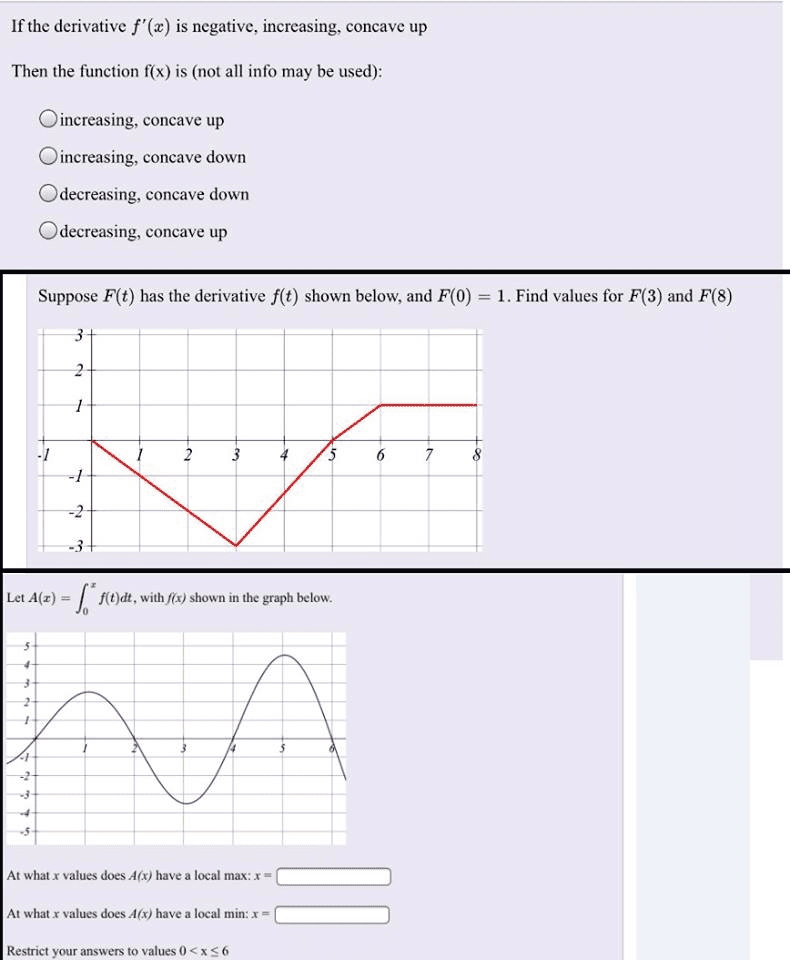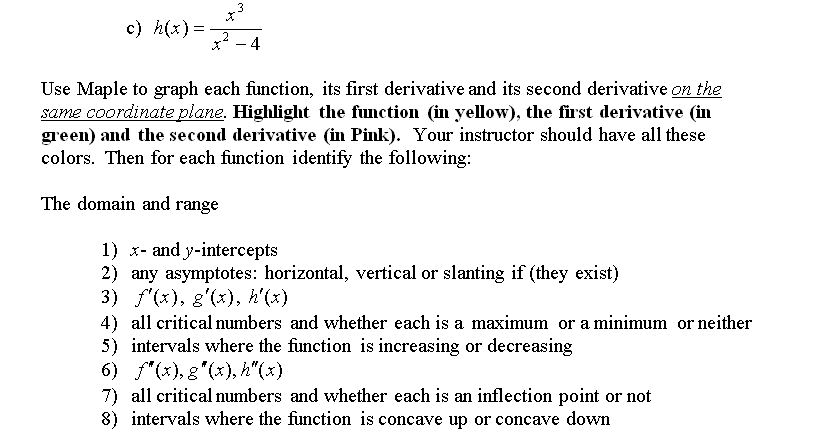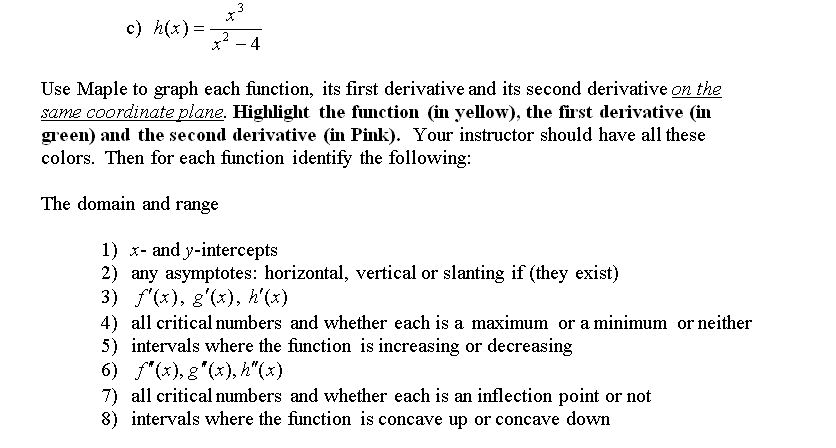MATH 220 Chapter Notes - Chapter 2.7: Second Derivative, Price Equation, Marginal Cost

C(x) = cost of producing x units of the product.
Marginal cost is C’(x), marginal anything is the revenue.
R(x) = revenue generated by selling x units of the product.
P(x) = R(x) - C(x) = the profit (or loss) generated by producing and selling x units of the
product.
Points about concavity and 2nd derivative: Second derivative is positive when the
function is concave up and that the second derivative of a function is negative when the
function is concave down. When the second derivative of a function is zero, the graph is
neither concave up nor concave.
- A function is concave up if there is an open interval on the x-axis through which
the graph of f(x) lies above its tangent.
- Concave down if there is an open interval on the x-axis containing A throughout
which the graph of f(x) is below its tangent line.
Graphs and the first derivative:
- If first derivative is greater than zero, then it is increasing
- If it is negative then it is decreasing at A
1) Suppose that the cost function for a manufacturer is given by C(x) = (10-6)x3-
.003x2+5x+1000 dollars
a) Describe the behavior of the marginal cost.
b) Sketch the graph of C’(x)
C’(x) = (3⋅10-6)x2- .006x + 5
C’’(x) = (6⋅10-6)x - .006
2) The demand equation for a certain product is p = 6 - 1 x thousand dollars. Find the
level of production that results in max revenue. 2
R(x) = x⋅p Find revenue function.
= x (6 - 1 x ) = 6x - 1 x2 thousand dollars
2 2
R’ (x) = 6 - x. Set equal to zero to find maximum.
x = 6
3) Setting up a demand equation. Company offers sightseeing tours for $7 per person,
with a demand of 1000 customers per week. When the price was lowered to $6, the
demand jumped to 1200 customers. Find the tour price that should be charged per
person to maximize the total revenue each week.
(x1,p1) = (1000,7) and (x2,p2) = (1200,6) Find the demand equation by using point-slope.
m = 7-6 = - 1 Use points to find slope.
1000-1200 200
= p - 7 = -1 (x - 1000) Fill out point-slope formula.
200
= p - 7 = -1x + 5
200
p = -1x + 12 Revenue function = x⋅p so multiply this by x.
find more resources at oneclass.com
find more resources at oneclass.com

200
R(x) = -1x2 + 12
200
R’(x) = - 1 (x-1200) Find derivative.
100
x = 1200 Set equal to zero, this is number of customers
p = 12 - 1 (1200) = 6 Put into equation for P to find price.
200
4) Maximizing profits. The demand equation is p = 100 - .01x and cost function is C(x) =
50x + 10,000. Find the value of x that maximizes the profit, and determine the
corresponding price and total profit for this level of production.
R(x) = x⋅p = x(100 - .01x) = 100x - .01x2 Find revenue function first.
Profit function is P(x) = R(x) - C(x) Find profit function.
= 100x - .01x2 - (50x + 10,000)
P (x) = -.01x2 + 50x - 10,000
P’(x) = -.02x + 50 = -.02(x-2500) Find derivative.
x = 2500 Set equal to zero.
P (2500) = -.01(2500)2 + 50(2500) - 10,000 = $52,500 Put x into P(x) to find total profit.
p = 100 - .01 (2500) = 100 - 25 = $75. Put into price equation to find what you should charge.
5) A airline carries 7650 per month, each paying $65 dollars. Research estimates that for
each $1 raise if fare, the airline will lose 90 passengers. Determine the price that
maximizes the airlines revenue.
(x1,p1) = (7650, 65), (x2,p2) = (7560, 66) Find demand equation
66 - 65 = - 1
7560-7650 90
p - 65 = -1/90 (x - 7650) Use point-slope formula
p - 65 = -1x/90 + 85
p = -1x/90 + 150
R(x) = x times p Find revenue function (Rx = x times p)
= -1x2/90 + 150x
R’(x) = - x + 150 Find derivative
45
0 = - x + 150 Set equal to zero
45
x = 6,750 This is the highest amount of passengers
p = 75 Sub into demand equation to find the best price
6) Given the cost function C(x) = 5x3 - 9x2 + 11x + 4 , find the minimum marginal cost.
C’(x) = 15x2 - 18x + 11 Find derivative, this is marginal cost
C’’(x) = 30x - 18 Find second derivative since looking for extreme points of marginal cost.
0 = 30x - 18
18 = 30x
find more resources at oneclass.com
find more resources at oneclass.com
Document Summary
C(x) = cost of producing x units of the product. Marginal cost is c"(x), marginal anything is the revenue. R(x) = revenue generated by selling x units of the product. P(x) = r(x) - c(x) = the profit (or loss) generated by producing and selling x units of the product. Points about concavity and 2nd derivative: second derivative is positive when the function is concave up and that the second derivative of a function is negative when the function is concave down. When the second derivative of a function is zero, the graph is neither concave up nor concave. A function is concave up if there is an open interval on the x-axis through which the graph of f(x) lies above its tangent. Concave down if there is an open interval on the x-axis containing a throughout which the graph of f(x) is below its tangent line. If first derivative is greater than zero, then it is increasing.






